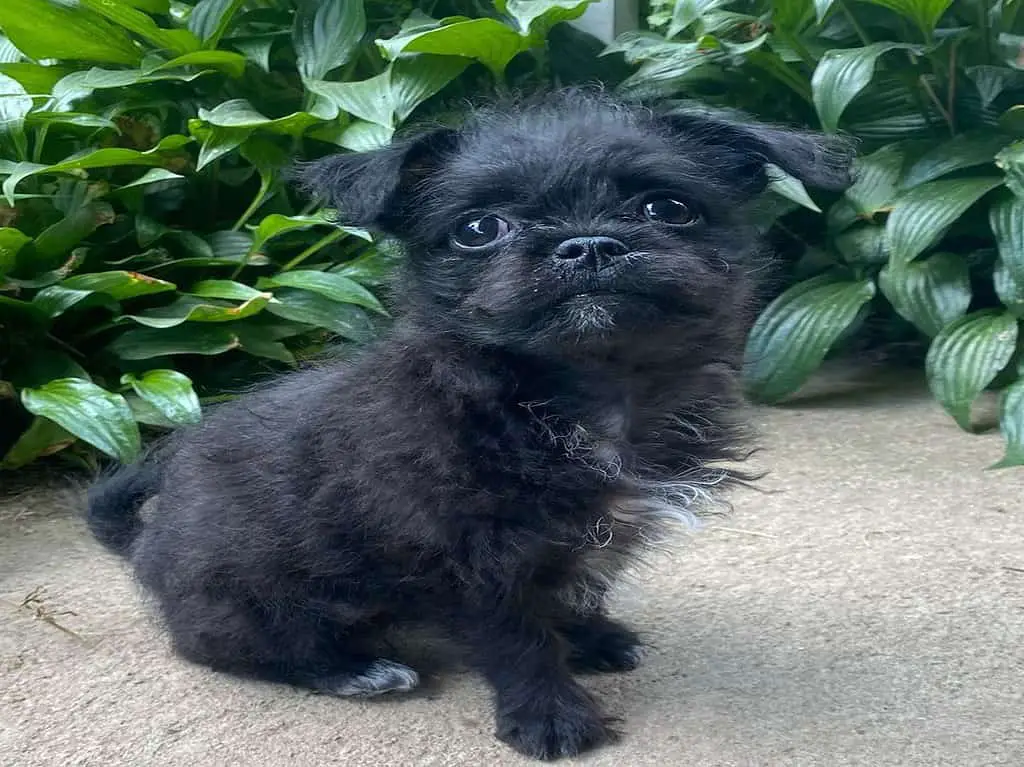Are you thinking of bringing home a furry friend to your family? Then you should totally check out the incredible Pug Maltese Mix dog breed.
This appealing canine is a combination of two good-natured breeds. The mixed breed’s personality is sure to warm the hearts of the whole family, and with proper care, diet, and exercise, this pup will make the perfect companion.

Quick Facts: Pug Maltese Mix
Height
7 - 15 inchesWeight
8 - 22 poundsLifespan
12 - 15 yearsBreed Size
small (0-25 lbs.)Breed Type
mixedBreed Group
companionTemperament
anxious, friendly, gentle, outgoing, playfulGood With
families, other dogs, cats, strangersIntelligence
highShedding
frequentExercise Needs
lowBarking Level
lowEnergy level
lowDrool Amount
lowCoat Type
short or long, soft or roughCoat Patterns
bi-color, tri-colorColors
black, fawn, whiteOther Characteristics
apartment-friendly, easy to train, good for first-time pet owners, high potential for weight gain, prone to health issues, tendency to chewPug Maltese Mix Highlights
- Families with minimal space are well-suited for owning a Pug Maltese Mix. This lovable pup will thrive in any environment whether you live in an apartment, condo, or small house.
- Despite their small size, Pug Maltese Mix dogs can comfortably tolerate rough playing with kids; however, it is imperative to oversee their interactions for maximum safety.
- These adorable pups are known for their friendly personalities and outgoing nature. They make great family pets and get along well with children, other dogs, and even strangers. While they may bark at unfamiliar noises or visitors to your home, they are unlikely to pose any real threat to potential intruders.
- Pug Maltese Mixes don’t require much exercise; they’re content with short bursts of activity throughout the day, like playing fetch in the living room or chasing after toys in the backyard.
- They are incredibly social dogs and love nothing more than hanging out with their family members, whether they’re two-legged or four-legged.
History
Where did the Pug Maltese Mix come from, and what are the breed’s origins?
It is deliberately bred from two ancient domesticated canines: the Pug, an affectionate and friendly breed hailing from China, and the Maltese, a spirited variety from Italy.
Pug

The Pug is native to China and has existed since before the Common Era. It was a beloved animal of the Chinese imperial families, enjoying a life of lavishness and receiving protection from guards on occasion. Historical data demonstrates that the Chinese developed three different varieties of dogs with shortened snouts: Lion-type, Pekingese, and Lo-sze (also known as a “Foo Dog”). The latter is closely related to today’s Pug.
The Dutch traders introduced Pugs to Holland and England from the East, resulting in its refinement into what we know as the modern-day display of the breed. European monarchs widely adopted this exhilarating little canine as a preferred pet, and it still enjoys a loyal following among distinguished global citizens today.
The AKC formally recognized the Pug in 1885, and its popularity drastically increased until the start of the 20th century. Despite this decline, several devoted breeders maintained their commitment to preserving the Pug, leading to a resurgence of their presence in the US. The growth rate of today’s Pug population has been relatively consistent, neither too plentiful nor too uncommon.
Maltese

The Maltese breed has existed for over two millennia; however, debate exists concerning its exact origin. Some suggest that these dogs can be traced back to Spitz-type ancestors in Sweden, while others attribute their ancestry to the Tibetan Terrier of ancient Asia.
The Maltese developed a place of significance throughout its long history. During the 15th century, it gained recognition from French aristocrats and flourished among their social circles. When Henry VIII came to power in the British Isles toward the end of the 16th century, it similarly found favor with nobles and royalty alike. Specifically, Queen Victoria, Queen Mary of Scots, and Queen Elizabeth I owned Maltese as pets, each immortalized in paintings by renowned artists.
During the 17th and 18th centuries, attempts were made to change the size of the Maltese breed, putting its existence in serious jeopardy. Subsequent efforts to restore the breed resulted in various interbreeding with poodles, miniature spaniels, and East Asian miniature dogs. Consequently, many researchers also believe these crosses are responsible for creating new breeds derived from the original Maltese form.
English breeders were responsible for the modern Maltese breed that is seen today. Most Maltese found in the United States can be traced back to those imported from England. The breed’s first appearance in America was noted sometime during the late 19th century, and they made appearances at Westminster Kennel Club shows as early as the 1870s.
Appearance

The Pug Maltese Mix exemplifies the characteristics of both parent breeds. It has a square-shaped physique and a deep chest appropriate for its size, along with a broad head that tapers at the muzzle, usually falling somewhere between the medium-length tapered muzzle of the Maltese and the very short, square muzzle of the Pug.
Pug Maltese Mix Size
The Pug Maltese Mix is a small dog typically weighing 8 to 22 pounds, making it an ideal choice for apartment dwellers or those with smaller homes.
Pug Maltese Mix Colors
The three main colors of the Pug Maltese Mix are white, black, and fawn.
White is the most common color in this breed, giving them a clean and polished look. It also makes their adorable square muzzle stand out even more prominently. Black provides a stunning contrast against their white fur and adds depth to their features. On the other hand, Fawn offers a softer tone that blends beautifully with their cuddly demeanor.
Coat
The coats of the Pug and Maltese vary considerably, resulting in crossbreeds that may manifest diverse coat types. The Pug Maltese Mix may inherit either a single or double-layer coat from the Pug or a long single-layer coat, which is flat and silky in nature, from the Maltese. This could result in an outwardly rough appearance yet have a surprisingly soft texture.
Personality


If you’re looking for a furry friend who’ll greet you with a wagging tail and a happy smile, the Pug Maltese Mix is the best choice. This adorable crossbreed is known for its friendly nature and outgoing personality, making it an ideal companion for families or individuals who love socializing.
But don’t expect your Pug Maltese Mix to protect your home or bark at intruders. Their friendly demeanor means they don’t make very good watchdogs. That’s not to say they won’t alert you to someone at the door – they just won’t be aggressive about it. Instead, these lovable pups are more likely to greet visitors with wagging tails and wet kisses.
Additionally, one aspect of their personality that can be challenging for some owners is their tendency to be anxious when left alone.
As a breed, these dogs tend to form strong bonds with their owners and can become quite attached. This attachment can lead to separation anxiety when left alone for too long. They may become restless or destructive, constantly screaming and chewing on furniture.
Health
Like all dogs, the ug Maltese Mix dog can be prone to certain health issues that owners should be aware of.
One common health issue in Pug Maltese Mix dogs is respiratory problems. Due to their short snouts inherited from the Pug side of their lineage, they can experience difficulty breathing and may even develop a condition called Brachycephalic Syndrome. This can lead to coughing, snoring, and even collapse in severe cases. It’s important for owners to monitor their dog’s breathing and seek medical attention if any concerning symptoms arise.
Another potential health concern for this breed is dental problems. Both the Pug and Maltese breeds are prone to dental issues such as gum disease or tooth decay, leading to further complications down the line.
Lifespan
The average lifespan of a Pug Maltese Miix is 12-15 years. That’s over a decade of cute, cuddly companionship.
Care
One of the best things about owning a Pug Maltese Mix is that they require minimal exercise. Unlike other dogs that need long walks or runs to keep them healthy, this breed only needs short walks or indoor playtime to stay happy. This makes them ideal for apartment living or people with busy schedules but still want a furry friend to come home to at the end of the day.
Unlike bigger dogs, Pug Maltese Mixes are suited to living in residences with a small backyard. They maintain relatively low energy levels, making them apt for apartment life; notwithstanding, be prepared for occasional bursts of energy.
Ensure that these dogs have an adequate supply of toys for entertainment. Furthermore, you may consider using a playpen to maintain their safety when you cannot supervise them closely.
And depending on the extent of training you provide them, these dogs will most likely not be excessively vocal. It is advisable to prepare yourself for a range of common issues experienced with most breeds, such as damaging behaviors (e.g. gnawing on items and attempting to obtain food by begging or digging). Nevertheless, by successfully implanting proper obedience techniques into their behavior process it can help shape them accordingly to your desires.
Diet
Read on for some essential tips on creating a balanced and nutritious diet for your Pug Maltese Mix.
This breed is prone to weight gain due to its small size and low activity level. Therefore, monitoring their calorie intake and not overfeeding them with high-calorie treats or table scraps are crucial.
Also, ensure your pup gets enough protein from lean sources like chicken or fish, as they need it for strong muscles and bones.
And don’t forget: Small dogs require less food than larger breeds, but that doesn’t mean you should skimp on quality. Look for high-quality dog food that’s formulated specifically for small breeds. This will ensure they get all the essential vitamins and minerals needed to thrive.
Grooming
Regular brushing of the Malti-Pug’s coat is highly encouraged to minimize fur shedding within the home. Furthermore, their dental hygiene requires attention, and owners should begin teaching these habits from a young age.
Pug Maltese Mix Puppies

Knowing the potential risks of opting for a cheaper option is important when selecting a breeder. Even if a low price does not invariably signify poor-quality dogs, there exists some potential that the breeding parents are being overbred. This can manifest in detrimental behavioral and physical issues among the Pug Maltese Mix puppies.
Do your research when selecting a breeder. Speak with your local kennel or hybrid club and trusted veterinarians and breeders of similar pups to identify those with a positive reputation. Additionally, look into reviews and ratings on various websites to assess the quality of their services.
There are also organizations dedicated specifically to different types of breeds whose members can pinpoint reliable options and alert individuals of those who may need to adhere to standards.
Children and Other Pets
This breed can keep up with your kids and other pets. Its friendly demeanor and playful attitude make it a great companion for humans and animals.
But listen: while these dogs are generally friendly towards children, they may become nervous or aggressive if they feel threatened or uncomfortable.
To ensure that your children stay safe while playing with your Pug Maltese Mix, be sure to supervise all interactions closely.
Rescue Groups
Many rescue groups are dedicated to rescuing, rehabilitating, and rehoming Pug Maltese Mixes. These organizations work tirelessly to offer these precious pups with medical care, love, and shelter. They also ensure that each dog finds their forever home with a loving family who will cherish them.
If you’re considering adopting a Malti-Pug, we recommend reaching out to one of these rescue groups.
Pug Rescue & Sanctuary Owasso, Inc.
Pug Pals (Greater Boise Pug Rescue and Placement)
American Maltese Association Rescue
Southern Comfort Maltese Rescue
Pug Maltese Mix FAQS
Are Pug Maltese Mix dogs hypoallergenic?
No, these dogs, unfortunately, can’t promise relief from allergies. So if you’re on the hunt for a hypoallergenic pooch, you may need to scratch the Pug Maltese Mix off your list.
Are Pug Maltese Mix dogs easy to train?
Yes, these dogs are a breeze to train. Whether you want them to master basic commands like “sit” and “stay” or more complex tricks like rolling over or fetching your slippers, these pups will be up for the challenge. Plus, because they love attention and praise from their owners, training will feel more like playtime than work.
How long does Pug Maltese Mixes live?
These adorable pups are known to live an impressive 12 to 15 years, making them the perfect companion for anyone who wants a lifelong furry companion.
Are Pug Maltese Mix dogs friendly?
Despite being small, these pups have big personalities that warm your heart. They love to be around people and are always eager to please them.
Are Pug Maltese Mixes quick learners?
If you’re set on the Pug Maltese Mix, you’ll be pleased to know that these dogs are quick learners. They have an innate curiosity and love to explore their surroundings. This makes them great candidates for training sessions where they can learn new tricks and commands.
Pug Maltese Mix Fun Facts
Here are some interesting tidbits that will make you fall even more in love with this lovable mixed breed.
- The Pug Maltese Mix is also commonly known as the Malti-Pug.
- They make great family pets as they get along well with children and other animals.
- These pups are on the smaller side, typically weighing between 8 – 22 pounds when fully grown, making them perfect for apartment living.
References
Ogata, N. (2016). Separation anxiety in dogs: What progress has been made in our understanding of the most common behavioral problems in dogs?. Journal of Veterinary Behavior, 16, 28-35.
Koch, D. A., Arnold, S., Hubler, M., & Montavon, P. M. (2003). Brachycephalic syndrome in dogs. Compendium on continuing education for practicing veterinarian north american edition-, 25(1), 48-55.




